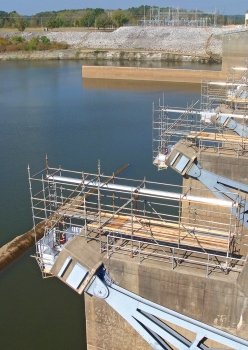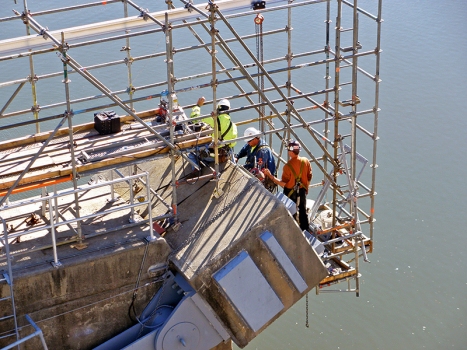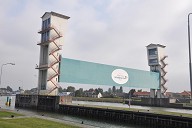Lift-off tests at West Point Dam and Robert F. Henry Dam
In the 1960s and 70s, the US Army Corps of Engineers regularly used high-strength, smooth, post-tension steel bar tendons for trunnion girder anchorages in many of the dams constructed in this period. These are the structural elements that were also used for the West Point flood control dam in Georgia and the Robert F. Henry lock and dam in Alabama, both of which were built in the 1960s.
Media
The challenges associated with this design method include difficulty with repair and inspection of the trunnion rods. This early form of post-tensioning limits the ability to perform in-place load tests since the bars are not threaded. Consequently, the Army Corps had been utilizing a nondestructive testing method at the West Point and Robert F. Henry dams that initiates and records impact vibration response (U.S. Patent 8096195) in the steel tendons without disturbing them. This measured wave motion is compared to the theoretical one and then used to determine the current tension force of the bar tendons in the structures, but the accuracy of this method is limited.
After the recent failure of several tendons from corrosion, the need to develop and employ a new and more conclusive tendon testing method became a priority. To ensure public safety, the Army Corps initiated an evaluation and maintenance program that utilized both the wave testing method and hydraulic monitoring of the tendon forces.
Mock-up of the trunnion anchorage
A full-scale test facility was constructed at FDH Engineering's office in North Carolina where a mock-up of the trunnion anchorage was built. This mock-up consisted of a large reinforced concrete block incorporating four full scale bar tendons. It was used to test and confirm the effectiveness of using hydraulics to evaluate and measure loads in the bars.
Load tests with a specially developed gripping device
DSI USA was contracted to perform the lift-off tests in order to determine the actual tensioning force of the bars currently in place in the dams. To accomplish this task, DSI's engineers first conducted load tests on the specially constructed mock-ups at FDH's test facility using a gripping device that had been specially developed by DSI. The gripping device was necessary because the bars used in the construction of these dams were smooth and without the threads which would have allowed for a coupling device.
Upon completion of the mock-up testing, DSI USA developed a suitable testing method for the tendons of both dams and then again tested them on site. DSI's experts had to find suitable places to test the tendons because they were located in areas of difficult access.
Out of a total of 376 post-tensioning tendons at West Point Dam and 476 tendons at Robert F. Henry Dam, DSI tested a total of 216 tendons and successfully determined and recorded their actual tension force. Having this information allowed the Corps of Engineers to make critical decisions on the condition and safety of both dams.
References
Structure Types
- About this
data sheet - Product-ID
7416 - Published on:
08/09/2016 - Last updated on:
17/11/2021











